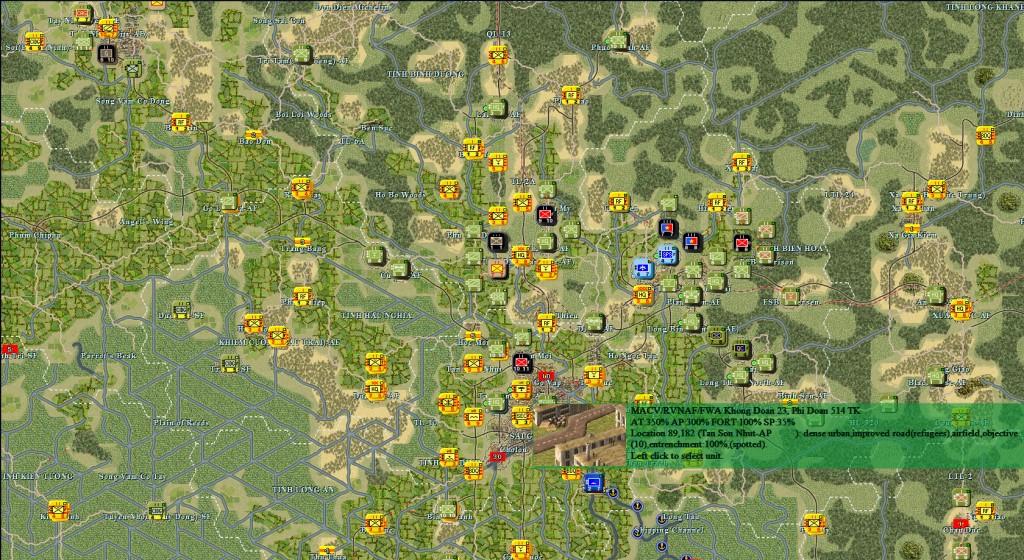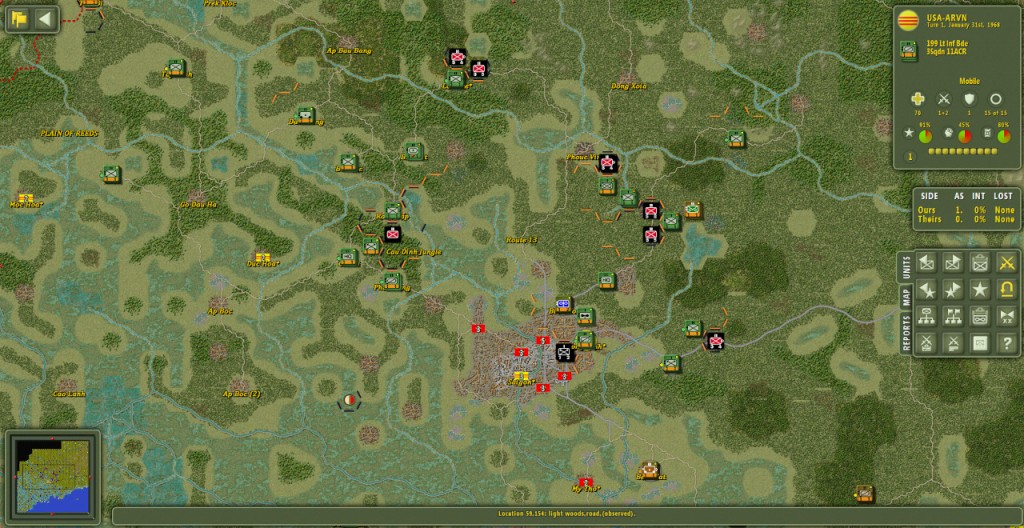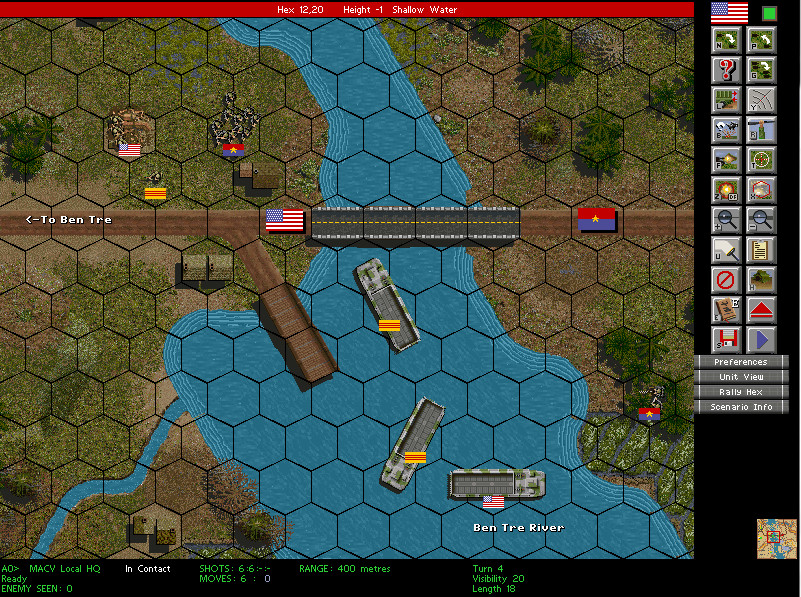Tags
1968, Cold War, Indigo Girls, Steel Panthers, Tet Offensive, The Operational Art of War, Vietnam, Vietnam Combat Operations, WinSPMBT
This is the one-hundred-fourteenth in a series of posts on the Vietnam War. See here for the previous post in the series and here to go back to the master post.
Today marks the 55th anniversary of the launch of the Tet Offensive in 1968. The combined forces of the National Liberation Front of South Vietnam (NLF aka the Viet Cong) and the North Vietnamese People’s Army of Vietnam (PAVN and, often, NVA) had been preparing for months to launch simultaneous attacks, all across South Vietnam, intended to seize the major urban areas. The anticipation was that the appearance of the “liberation” soldiers would spark a “general uprising,” whereby the people would seize power from the corrupt “puppet” government in the South. The attack was to occur in the early morning hours of January 31st, but premature assaults on the 30th gave precious advanced warning of the impending operation.
Readers of this blog will know that I’ve been dreaming about the treatment of the Tet Offensive within games for many years now. As with Operation Starlite, the bits and pieces that comprise the Tet attacks are featured in most of the Vietnam-era games that I own; from the grand-strategic down to the first person shooter. All these years I’ve been anticipating diving into this cornucopia of gaming options.
Now that I am actually here, I have to say I feel a little bit let down. Maybe it is just me; a case of the mid-winter doldrums perhaps? While that is surely is part of it, it may also be that the Tet Offensive is even less suited to my wargames than some other of the operations that I’ve looked at previously. While it was a big operation, it was really just counter-insurgency writ large rather than the large unit actions that wargames prefer to model.

I started by picking up where I left off with Vietnam Combat Operations, this time #7. The opening turn, beginning on January 31st, is unlike any other turn that came before in the series – as it should be. It has the NLF kick off the action with simultaneous attacks all across the map. Similarly, the series’ unique gameplay involving a series of missions for each turn (which I’ve spoken so favorably about in the past) remains, but for the first few turns there are practically no instructions for the gamer to follow. The nature of the surprise attack means player, like the allied high command, must react to events. There are far more fires to be put out than there are fireman to throw into the fight.
The theater-wide operational scope of Vietnam Combat Operations is, broadly speaking, not suited to the small-scale, irregular warfare that made up the details of the Tet Offensive. Still, this module has always done an admirable job of using scripting to fill in the gap between TOAW‘s combat results tables and the much-smaller scale fighting that drive those results. #7 continues in this regard although I do detect some measure of struggle. For example, fighting that should have taken a matter of days can wind up spread out over weeks due to the coarseness of the turns. Part of it is again me in that I’ve never got the hang of the multi-impulse system in TOAW III. I tend to accomplish less in each turn that I would really like to, and almost certainly could with better planning.

As before, there is another TOAW scenario that covers the same ground as Vietnam Combat Operations, but at a finer scale. The Light Grows Dim: The Tet Offensive is a more traditional TOAW treatment of the uprising, set at a scale of 1 day per turn. It has been part of the TOAW package since its early iterations and, in TOAW III, is found in the “Classic TOAW” scenario folder. I’ve complained before that, sometimes, the nature of the TOAW engine means these scenarios play out as the historical order of battle scattered about a reasonably-accurate map rather than a representation of the historical events. I see this again, but I’ll not dwell on it.
Instead, I am going to bellyache about the special scripting that tries to better model this historical factors. To quote from the scenario information screen:
Most of the Allied units are severely understrength. Historically, this mirrors the fact that only one serviceman in seven in the US Army was actually involved in direct combat.
The South Vietnamese units were also cut to half strength or less, many soldiers being on leave for the holiday.
The tactical surprise and scope of the Communist attacks caused great confusion among Allied units all over the country. For that reason, they begin in a state of shock that limits their activities for the first three turns.
Bad weather (which actually happened) during the first few days of Tet severely limited the use of air support.To put it another way, for the American first turn, there are but a handful of units that can move, shoot, or even just dig in, and these are virtually useless as fighting units due to being modeled as understrength. More pieces become controllable as each turn passes but, even by turn 3 or 4, their isn’t much for you to do.
Except watch your units get hammered by the full-strength NVA attacks.
While I appreciate the reality that is being game-i-fied here, watching your units get attacked with no ability to interact with the game isn’t good gameplay. Furthermore, the perception* of the U.S. command, by the first days of February, was that they had everything under control. Contrast that with a literal inability to control your own units.
Point is, it doesn’t feel right to me.

Compare, for example, the very similar map focus and timestamp of the first two screenshots, above. In the first, from Vietnam Combat Operations, the historically-contested portions of Saigon are shown as being under enemy control. The ARVN artillery and armored depot at Go Vap, correctly, has fallen and will, admittedly, require more to retake the position than the historical “hours” in which the 4th Vietnamese Marine Corps Battalion accomplished such. The ethnic Chinese Cholon neighborhood, too, will be a tough nut to crack in game and was, in fact, contested for more than a month. The point is that the NLF successes are isolated and the ARVN clearly have the forces to eventually prevail.
Contrast with the second screenshot where nearly the entire city is lost and, even as the days go by, there are no units under command to move into position, much less fight for control. Recall that the most newsworthy event of the Battle of Saigon occurred on February 1st (Turn 2!) when an ARVN general publicly executed a VC officer found in civilian clothing. This illustrates how, almost immediately, the ARVN forces in Saigon were able to retake the initiative.
Bottom line, as I indicated above, I just don’t get the right vibe from this one. I’ll try to play out the scenario to its conclusion but, for now, I’ve paused so as to dive down deeper into some tactical modeling of various engagements as communists launched their attacks.

The Light Grows Dim was put together by player/scenario designer Wild Bill Wilder (Why-uld-der, I’m pretty sure), who was one of the top content producers in the heyday of these toolkit wargames. It is therefore not surprising to find that he also built a Steel Panthers scenario for the Tet Offensive. That scenario, Not Here, Not Now, models the unprepared and overwhelmed defenders attempt to stop the offensive in the Mekong Delta region by holding a river crossing. This engagement, The Battle of Bến Tre, is best remembered for a quote, controversially attributed to a U.S. major; “It became necessary to destroy the town to save it.”

It’s an interesting battle and one that demonstrated how America’s support units (riverine, artillery, and aircraft) could make up for an utter lack of adequate forces on the ground. It’s also an interesting scenario design, seemingly presented as a set of puzzles to solve. Is it possible to keep enough units alive to mount an effective defense? (Not me, I lost almost all my boats very quickly to RPGs… again, unable to move or fight due to shock).
There is also an additional, and admittedly a-historical, inclusion of a South Vietnamese dignitary (his family is depicted as a Steel Panthers unit) who needs to be rescued. This is a nod to the reality that the Tet Offensive included assassination squads as well as general instructions to eliminate any and all collaborators found in captured territory. What was originally intended as a controlled political operation quickly spun out of control into a mass execution of civilians. A name on a list (as read by barely-literate teens) or even whispers from the neighbors might get you summarily shot.
Once again, I don’t find the imbalance particularly fun as a game. Maybe it’s just my seasonal affective disorder talking. Or maybe not, because…
… well, stay tuned for part 2.
*Hue 1968 explains how, especially in Hue, the U.S. high command drastically and tragically underestimated what they were facing, sending inadequate forces against vastly superior numbers. It also explains how, in Saigon and throughout much of the South, the “surprise” part of the surprise attack aside, it was far less of a big deal militarily than the press and the folks at home understood it to be.

Pingback: The Less I Seek My Source for Some Definitive | et tu, Bluto?
Pingback: Painted Wings and Giant’s Rings | et tu, Bluto?
Pingback: Fugit Inreparabile Tempus | et tu, Bluto?
Pingback: Giggity | et tu, Bluto?
Pingback: ‘Til My Ammunition is Dry | et tu, Bluto?
Pingback: Love in the Middle of a Firefight | et tu, Bluto?